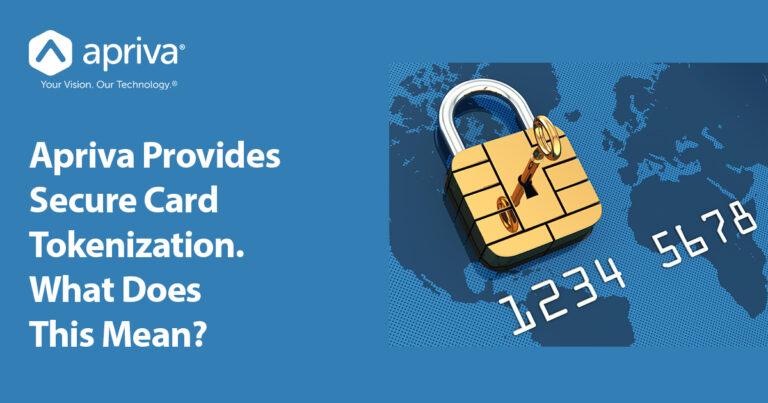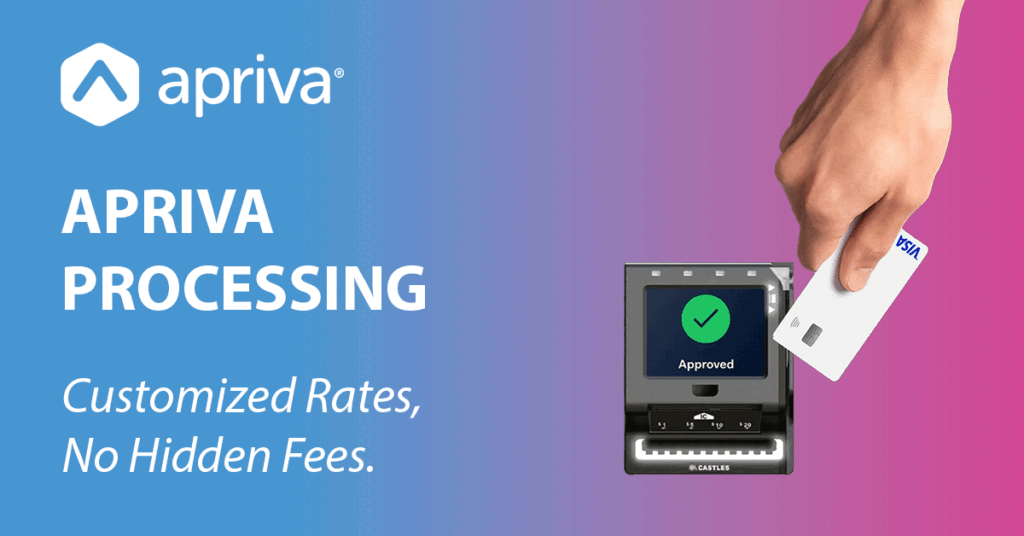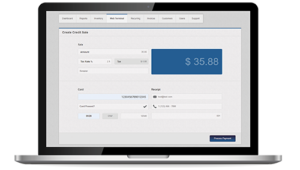Apriva Provides Secure Card Tokenization and Encryption for Standard and Card Not Present Transactions.

Card tokenization, encryption, what does this all mean, and why does it matter for your business?
Card tokenization, encryption, what does this all mean, and why does it matter for your business? The bottom line is, the smart business in today’s world offers safe and secure payment options for customers, such as card not present payments (which require tokenization), and accepts any method of payment that a customer wants to use. Apriva can help any size business, in any industry, do just that. Click here to learn more about the different payment methods we support, and keep reading to learn more about tokenization.
In the simplest terms, encryption hides data, and tokenization de-values data. Encryption means when customers use their physical cards, Apriva encrypts the data to keep it safe as it travels to and from our gateway. Tokenization means we’re not only protecting stored “card on file” or “card not present” data so customers don’t have to use their physical cards at all, but we’re also securely authenticating that data so the merchant can process payment without accepting a physical card. The latest in payment tokenization provides an even safer and more efficient payment experience for merchants and customers.
Apriva offers both standard encryption, and “card on file” tokenization.
What are the benefits of accepting “card not present” payments?
The benefit to customers is tokenization reduces the number of times they have to expose and use their card. In fact, the whole point of “card not present” tokenized payments is to not have to show your card at all, and to use a different method like the ones we’re going to review in a moment (biometrics, QR, code, member number, stored subscription information for recurring payments, etc…) to authenticate payment.
The benefits to merchants include a super-fast and super-secure payment process that does not require the presence of a physical card, and often is self-service and does not require employee involvement. Another benefit is that in today’s world, consumers expect to be able to pay any way they want. The smart business will not just accept cash, credit, and debit, but will accept alternative methods such as PayPal, Venmo, QR codes, biometrics such as fingerprints or facial recognition, smart devices, recurring payments when appropriate, and more, all of which Apriva can help with.
The smart business will not just accept cash, credit, and debit, but will accept alternative methods such as PayPal, Venmo, QR codes, biometrics such as fingerprints or facial recognition, smart devices, recurring payments when appropriate, and more, all of which Apriva can help with.
Furthermore, after implementing tokenization, merchants consistently see an increase in authorization rates, and a reduction in liabilities since they aren’t responsible for storing sensitive account data.

More Revenue
Tokenization boosts authorization rates, increasing conversions and sales, and lowering IT/security-liability overhead.

Better Customer Experience
Tokenization delivers fast self-service checkout experiences, and more personalized shopping experiences.

Increased Security
Tokenization is more secure than standard encryption, keeping payment data secure inside all merchant locations, via any payment method, lowering merchant risk of data breaches, and reducing PCI DSS compliance scope.
What is Encryption?
While all Gateways have to offer encryption, not all Gateways can offer tokenization. Apriva does. Tokenization takes encryption to a whole new level. It’s about much more than swapping payment data for a substitute binary string. It’s about improving user experience and security across in-person and e-commerce payments by allowing customers to complete “card not present” transactions. Many companies interchange the terms Encryption and Tokenization and will claim they can tokenize card data, when really, they’re just encrypting card data. True tokenization is not only more secure and cannot be mathematically reversed by anyone, it also has to do with “card on file” tokenization. Have you ever paid with biological data (fingerprints, facial recognition), QR codes, smart phones or watches, signed up for recurring payments, paid a digital invoice, or anything other than a “present” debit or credit card? Or has your card data been replaced by something of low value, like at a theme park if payment information (high-value) is be replaced with a rubber wristband (low-value) so you don’t have to carry cash or cards with you? Then you have completed a transaction with a merchant who uses a Gateway that can tokenize card data. Like Apriva.
This process is called “Vaulted Tokenization” stored in something called an “HSM Server”. This is “card on file” tokenization that is a specialized ability, not general encryption that any payment gateway has to provide.
Real World Examples of Tokenization
Company A: 360 Degree View of Customer Trends
Let’s imagine Company A is a big-box clothing retail store offering loyalty points to customers. If your payment information is tokenized with Company A, then no matter what store a customer visits, or how they pay (with your smart phone or watch, a QR code, a loyalty account number, or biometrics such as facial recognition), they will receive full loyalty points for any of these methods, and Company A will have a 360 degree view into their transaction data and behaviors.
Company B: Faster More Secure Checkout
Let’s imagine a beverage business called “Company B” that operates in places with high demand, like a sporting arena. Company B needs to speed up their service and payment acceptance to get huge numbers of customers through their lines and back to the event as quickly as possible. So, they set up an automated beverage dispensing system that accept facial recognition to approve “card on file” payment so no one has to take the time to pay with a card or hand it to a person. The first time a customer comes to Company B, they will provide their card one time to an employee and take a picture of the customers’ face (or other biological data being used to authenticate payment). Remember, tokenization de-values data. So now the customer’s face is replacing their physical card. Once that card data (PAN, CVV, and expiration date) is tokenized in Apriva’s gateway, we turn it into two pieces. The first piece we store privately within our Gateway. This piece is not returned to the Company B. The second piece goes through the regular transaction process and back to Company B to release payment to them, just like normal. Because of this process, Apriva now has that customers’ card “on file”, which can be authenticated by the customer’s photo. So, the next time this customer walks up to Company B for a beverage, they only have to scan their face (or QR code or member number or thumbprint, etc…), and once it is authenticated, Apriva confirms and releases the stored and tokenized card data so Company B gets paid, and the customer makes it through their transaction quickly and without ever presenting their card.
Contact us today to learn more, and to enjoy the benefits of card not present tokenization!



